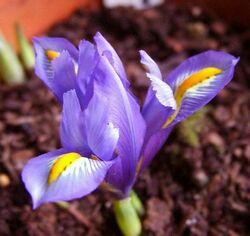Biology:Iris hyrcana
| Iris hyrcana | |
|---|---|

| |
| Scientific classification | |
| Kingdom: | Plantae |
| Clade: | Tracheophytes |
| Clade: | Angiosperms |
| Clade: | Monocots |
| Order: | Asparagales |
| Family: | Iridaceae |
| Genus: | Iris |
| Subgenus: | Iris subg. Hermodactyloides |
| Section: | Iris sect. Reticulatae |
| Species: | I. hyrcana
|
| Binomial name | |
| Iris hyrcana Woronow ex Grossh
| |
Iris hyrcana, the Hyrcana iris, is a plant species in the genus Iris, it is classified in the subgenus Hermodactyloides and section Reticulatae. It is a bulbous perennial from central Asia, from Azerbaijan to Iran.
Description
Iris hyrcana has spherical bulbs,[1] that are coated with a solid brown fiberous network.[2]
The leaves appear after flowering,[2] it has 10 cm (3.9 in) high stems.[3][4]
In the Northern Hemisphere it blooms in the winter, between November and January,[5][3] or sometimes in February.[2] The flowers are around 2.5–3 cm (0.98–1.18 in) wide.[2][4] The flowers are much smaller than those of other Reticulata irises.[2]
Like other irises, it has two pairs of petals, three large sepals (outer petals), known as the "falls", and three inner, smaller petals (or tepals), known as the "standards".[6]:17 They come in shades of blue, from clear blue,[5][3][7] to dark blue and purple.[2] The falls have a bright yellow ridge,[5] or orange mark.[2][7]
Biochemistry
As most irises are diploid, having two sets of chromosomes, this can be used to identify hybrids and classification of groupings.[6]:18 It was counted as 2n=20,[2]
Taxonomy
The specific epithet hyrcana, refers to Hyrcania, a historical region composed of the land south-east of the Caspian Sea in modern-day Iran.[8]
In 1848, specimens of the plant were originally collected in Azerbaijan.[9] It was described and published in 'Flora Kavkaza' by Alexander Grossheim in 1928.[10]
Iris hyrcana is now an accepted name by the RHS,[11] and it was verified by United States Department of Agriculture and the Agricultural Research Service on 4 April 2003, then updated on 11 December 2024.[12]
It is listed in 1995 in 'Vascular Plants of Russia and adjacent States (the former USSR)' by Czerepanov, S. K.[13]
It was once though to be a variant of Iris reticulata,[2][5] except Iris hyrcana has spherical bulbs where as Iris reticulata bulbs are drop shaped.[1]
Distribution and habitat
Iris hyrcana is native to temperate areas of western Asia.[12][2]
Range
Originally found in the Hyrcanian woods,[3] along the southern coast of the Caspian Sea from Azerbaijan to Iran.[1][12][2]
Habitat
It is found growing in the mountains along the Caspian Sea.[2]
Cultivation
It prefers to grow in sunny sites, on rocky soils that dry out completely in summer.[2]
As it is not very hardy, but it can withstand strong frosts of short duration.[2] Although it is thought to be best grown in the UK and in America, within a bulb frame or alpine house,[5] to keep the soils dry.[2] It also needs a dry, summer dormancy of several months.[2]
A specimen of Iris hyrcana won the Farrer Medal at the AGS Caerleon Show, in South Wales, shown by Bob and Rannveig Wallis.[14]
Toxicity
Like many other irises, most parts of the plant are poisonous (rhizome and leaves), if mistakenly ingested can cause stomach pains and vomiting. Also handling the plant may cause a skin irritation or an allergic reaction.[15]
References
- ↑ 1.0 1.1 1.2 "Iris hyrcana". encyclopaedia.alpinegardensociety.net. http://encyclopaedia.alpinegardensociety.net/plants/Iris/hyrcana. Retrieved 18 July 2014.
- ↑ 2.00 2.01 2.02 2.03 2.04 2.05 2.06 2.07 2.08 2.09 2.10 2.11 2.12 2.13 2.14 2.15 "Chapter III bulbous iris". irisbotanique.over-blog.com. https://irisbotanique.over-blog.com/article-chapitre-iii-iris-bulbeux-71708991.html. Retrieved 21 March 2018.
- ↑ 3.0 3.1 3.2 3.3 "IRIS HYRCANA". cgf.net. http://www.cgf.net/plantdetails.aspx?id=14204. Retrieved 21 March 2018.
- ↑ 4.0 4.1 "(SPEC) hyrcana". wiki.irises.org (American Iris Society). http://wiki.irises.org/bin/view/Spec/SpecHyrcana?id=1&filename=hyrcana-75k.jpg#igp1. Retrieved 18 July 2014.
- ↑ 5.0 5.1 5.2 5.3 5.4 "Reticulata Irises". www.pacificbulbsociety.org. 11 May 2014. http://www.pacificbulbsociety.org/pbswiki/index.php/ReticulataIrises. Retrieved 14 July 2014.
- ↑ 6.0 6.1 Austin, Claire (2005). Irises; A Garden Encyclopedia. Timber Press. ISBN 978-0-88192-730-6.
- ↑ 7.0 7.1 "Iris hyrcana". rareplants.co.uk. https://www.rareplants.co.uk/product/iris-hyrcana/. Retrieved 21 March 2018.
- ↑ Massoume Price Iran's Diverse Peoples: A Reference Sourcebook, p. 30, at Google Books
- ↑ Original material of Iris hyrcana Woronow ex Grossh. [family IRIDACEAE]. jstor.org. http://plants.jstor.org/stable/10.5555/al.ap.specimen.le00014041. Retrieved 21 March 2018.
- ↑ Iridaceae Iris hyrcana Woronow ex Grossh.. 1. www.ipni.org (International Plant Names Index). 2005. http://www.ipni.org/ipni/idPlantNameSearch.do?id=438720-1. Retrieved 18 July 2014.
- ↑ "Iris hyrcana". www.rhs.org.uk. https://www.rhs.org.uk/Plants/9274/Iris-hyrcana/Details. Retrieved 31 October 2014.
- ↑ 12.0 12.1 12.2 {{citation | mode = cs1 | title = Iris hyrcana | work = Germplasm Resources Information Network (GRIN) | url = | publisher = [[Organization:Agricultural Research ServAgricultural Research Service (ARS), United States Department of Agriculture (USDA) | access-date = 23 February 2018 }}
- ↑ Vascular plants of Russia and adjacent states (the former USSR), p. 281, at Google Books
- ↑ "Iris hyrcana won the Farrer Medal at the AGS Caerleon Show, shown by Bob & Rannveig Wallis". twitter.com. 15 Feb 2014. https://twitter.com/JimMcGregorAGS/status/434691760917590016. Retrieved 18 July 2014.
- ↑ David G Spoerke and Susan C. Smolinske Toxicity of Houseplants, p. 236, at Google Books
Other sources
- Komarov, V. L. et al., eds. 1934–1964. Flora SSSR. [lists as I. hyrcana (Woronow)]
- Mathew, B. 1981. The Iris. 177
External links
Wikidata ☰ Q20720087 entry
 |

